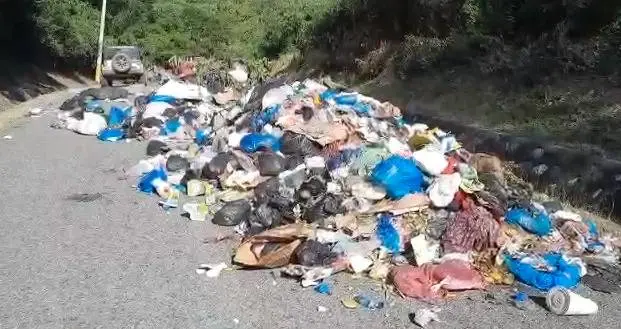Why is recycling imperative in the country?
Why is recycling imperative in the country? Dominican Today


Sustainable and Integral Solid Waste Management Program in Greater Santo Domingo

The Dominican Republic is facing urgent challenges in implementing the Inter-American Development Bank (IDB) project, in collaboration with the Japan International Cooperation Agency (JICA) and the International Cooperation Office (AECID), to manage the Integral and Sustainable Solid Waste Management Program in Greater Santo Domingo. This project requires a total investment of US$110 million.
Reasons for Urgency
- The Dominican Republic ranks fourth in Latin America and the Caribbean in terms of environmental damage caused by waste generation. Each inhabitant produces 650 kilograms of solid waste per year, resulting in over 7 million tons of solid waste generated in the country. The presence of 240 open dumps exacerbates the problem.
- Only 3% of solid waste in the Dominican Republic enters the circular economy, compared to an average of 15% in the region and over 65% globally. This low rate hinders sustainable waste management practices.
- 50% of the waste generated in the country is organic, leading to increased greenhouse gas emissions and posing severe health risks due to poor management.
Background
This situation can be attributed to various factors, including the partial non-observance of Law No. 3455 of 1952 on the Organization and Administration of the Municipalities (already repealed), harmful practices of most municipalities, and the centralized control exerted by the National Government until the late 1990s. The management of garbage in most municipalities and Greater Santo Domingo was assumed, either fully or partially, by the Executive Power.
Consequences of Inaction
If the current situation remains unchanged, untreated solid waste could lead to floods, diseases, global warming, climate change, and contamination of seas and oceans. These consequences would have devastating effects on both the country and the planet.
Potential Solutions
Legislation such as General Law 64-00 on Environment and Natural Resources (enacted in 2000) and Law 176-07 on the National District and Municipalities (enacted several years later) could contribute to better waste management practices.
The IDB project serves as a crucial first step towards implementing a sustainable development agenda centered around proper solid waste management.
Benefits of Proper Waste Management
If waste is managed through recycling, significant environmental, social, and economic benefits can be achieved. These include:
- Reduction of greenhouse gas emissions
- Savings in raw materials
- Improvement of the country’s energy matrix
- Job creation
- Increased investment
In particular, the presence of organic waste in the country offers an opportunity to develop a robust organic fertilizer industry. Techniques such as composting have been developed in recent years, producing high-quality organic fertilizers that can enhance agricultural soils.
Mature composts from organic waste are more stable and of better quality compared to conventional inorganic fertilizers.
By properly managing waste, a potential source of harm can be transformed into a source of life, providing organic fertilizer for food production and improving the overall quality and health benefits of our food.
SDGs, Targets, and Indicators
| SDGs | Targets | Indicators |
|---|---|---|
| SDG 11: Sustainable Cities and Communities | 11.6: By 2030, reduce the adverse per capita environmental impact of cities, including by paying special attention to air quality and municipal and other waste management | – Percentage of solid waste entering the circular economy – Percentage of organic waste properly managed |
| SDG 12: Responsible Consumption and Production | 12.5: By 2030, substantially reduce waste generation through prevention, reduction, recycling, and reuse | – Percentage of solid waste entering the circular economy – Percentage of organic waste properly managed |
| SDG 13: Climate Action | 13.3: Improve education, awareness-raising, and human and institutional capacity on climate change mitigation, adaptation, impact reduction, and early warning | – Reduction in greenhouse gas emissions from improved waste management – Increase in public awareness of the environmental impact of waste |
| SDG 14: Life Below Water | 14.1: By 2025, prevent and significantly reduce marine pollution of all kinds, in particular from land-based activities, including marine debris and nutrient pollution | – Reduction in marine pollution caused by improper waste management |
| SDG 15: Life on Land | 15.3: By 2030, combat desertification, restore degraded land and soil, including land affected by desertification, drought, and floods, and strive to achieve a land degradation-neutral world | – Improvement in soil quality through organic waste composting |
1. Which SDGs are addressed or connected to the issues highlighted in the article?
SDG 11: Sustainable Cities and Communities
The article discusses the urgent need for the Dominican Republic to implement a solid waste management program in Greater Santo Domingo. This aligns with SDG 11, which aims to make cities and human settlements inclusive, safe, resilient, and sustainable.
SDG 12: Responsible Consumption and Production
The article highlights the low percentage of solid waste entering the circular economy in the Dominican Republic and the need for better waste management practices. This relates to SDG 12, which focuses on promoting sustainable consumption and production patterns.
SDG 13: Climate Action
The article mentions the generation of greenhouse gases due to poor waste management practices and the potential consequences of climate change. This connects to SDG 13, which aims to take urgent action to combat climate change and its impacts.
SDG 14: Life Below Water
The article discusses the potential negative consequences of untreated solid waste, such as contaminated seas and oceans. This relates to SDG 14, which focuses on conserving and sustainably using the oceans, seas, and marine resources.
SDG 15: Life on Land
The article mentions the opportunity to develop an organic fertilizer industry through proper waste management, which can improve soil quality. This aligns with SDG 15, which aims to protect, restore, and promote sustainable use of terrestrial ecosystems.
2. What specific targets under those SDGs can be identified based on the article’s content?
– Target 11.6: By 2030, reduce the adverse per capita environmental impact of cities, including by paying special attention to air quality and municipal and other waste management.
– Target 12.5: By 2030, substantially reduce waste generation through prevention, reduction, recycling, and reuse.
– Target 13.3: Improve education, awareness-raising, and human and institutional capacity on climate change mitigation, adaptation, impact reduction, and early warning.
– Target 14.1: By 2025, prevent and significantly reduce marine pollution of all kinds, in particular from land-based activities, including marine debris and nutrient pollution.
– Target 15.3: By 2030, combat desertification, restore degraded land and soil, including land affected by desertification, drought, and floods, and strive to achieve a land degradation-neutral world.
3. Are there any indicators mentioned or implied in the article that can be used to measure progress towards the identified targets?
– Percentage of solid waste entering the circular economy: The article mentions that only 3% of solid waste in the Dominican Republic enters the circular economy, compared to an average of 15% in the region and over 65% in the rest of the world. This indicator can measure progress towards targets 11.6 and 12.5.
– Percentage of organic waste properly managed: The article states that 50% of the waste generated in the country is organic, which increases the generation of greenhouse gases due to poor management. Improving the management of organic waste can contribute to achieving targets 11.6, 12.5, and 15.3.
– Reduction in greenhouse gas emissions from improved waste management: The article highlights the generation of greenhouse gases due to poor waste management practices. Monitoring and reducing greenhouse gas emissions can measure progress towards target 13.3.
– Increase in public awareness of the environmental impact of waste: The article mentions the need for creating awareness among the population about the environment and waste management. This indicator can measure progress towards target 13.3.
4. Table: SDGs, Targets, and Indicators
| SDGs | Targets | Indicators |
|---|---|---|
| SDG 11: Sustainable Cities and Communities | 11.6: By 2030, reduce the adverse per capita environmental impact of cities, including by paying special attention to air quality and municipal and other waste management | – Percentage of solid waste entering the circular economy – Percentage of organic waste properly managed |
| SDG 12: Responsible Consumption and Production | 12.5: By 2030, substantially reduce waste generation through prevention, reduction, recycling, and reuse | – Percentage of solid waste entering the circular economy – Percentage of organic waste properly managed |
| SDG 13: Climate Action | 13.3: Improve education, awareness-raising, and human and institutional capacity
Behold! This splendid article springs forth from the wellspring of knowledge, shaped by a wondrous proprietary AI technology that delved into a vast ocean of data, illuminating the path towards the Sustainable Development Goals. Remember that all rights are reserved by SDG Investors LLC, empowering us to champion progress together. Source: dominicantoday.com
Join us, as fellow seekers of change, on a transformative journey at https://sdgtalks.ai/welcome, where you can become a member and actively contribute to shaping a brighter future.
|








